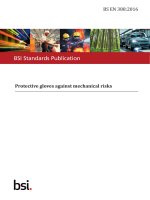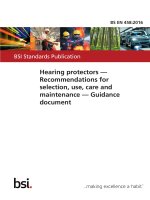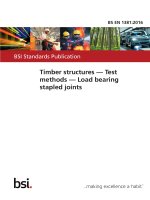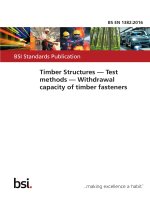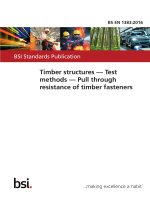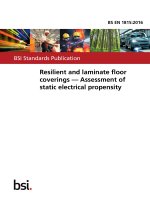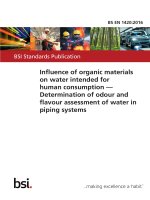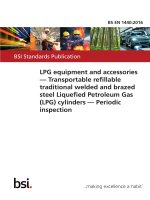Bsi bs en 61377 2016
Bạn đang xem bản rút gọn của tài liệu. Xem và tải ngay bản đầy đủ của tài liệu tại đây (1.9 MB, 52 trang )
BS EN 61377:2016
BSI Standards Publication
Railway applications —
Rolling stock — Combined
test method for traction
systems
BRITISH STANDARD
BS EN 61377:2016
National foreword
This British Standard is the UK implementation of EN 61377:2016. It is
identical to IEC 61377:2016. It supersedes BS EN 61377-1:2006, BS EN
61377-2:2002 and BS EN 61377-3:2002, which are withdrawn.
The UK participation in its preparation was entrusted by Technical
Committee GEL/9, Railway Electrotechnical Applications, to Subcommittee
GEL/9/2, Railway Electrotechnical Applications - Rolling stock.
A list of organizations represented on this committee can be obtained on
request to its secretary.
This publication does not purport to include all the necessary provisions of
a contract. Users are responsible for its correct application.
© The British Standards Institution 2016.
Published by BSI Standards Limited 2016
ISBN 978 0 580 83950 4
ICS 45.060.01
Compliance with a British Standard cannot confer immunity from
legal obligations.
This British Standard was published under the authority of the
Standards Policy and Strategy Committee on 30 April 2016.
Amendments/corrigenda issued since publication
Date
Text affected
BS EN 61377:2016
EUROPEAN STANDARD
EN 61377
NORME EUROPÉENNE
EUROPÄISCHE NORM
April 2016
ICS 45.060
Supersedes EN 61377-1:2006, EN 61377-2:2002,
EN 61377-3:2002
English Version
Railway applications - Rolling stock - Combined test method for
traction Systems
(IEC 61377:2016)
Applications ferroviaires - Matériel roulant - Méthode
d'essais combinés pour systèmes de traction
(IEC 61377:2016)
Bahnanwendungen - Bahnfahrzeuge - Kombiniertes
Prüfverfahren für Traktionssysteme
(IEC 61377:2016)
This European Standard was approved by CENELEC on 2016-02-23. CENELEC members are bound to comply with the CEN/CENELEC
Internal Regulations which stipulate the conditions for giving this European Standard the status of a national standard without any alteration.
Up-to-date lists and bibliographical references concerning such national standards may be obtained on application to the CEN-CENELEC
Management Centre or to any CENELEC member.
This European Standard exists in three official versions (English, French, German). A version in any other language made by translation
under the responsibility of a CENELEC member into its own language and notified to the CEN-CENELEC Management Centre has the
same status as the official versions.
CENELEC members are the national electrotechnical committees of Austria, Belgium, Bulgaria, Croatia, Cyprus, the Czech Republic,
Denmark, Estonia, Finland, Former Yugoslav Republic of Macedonia, France, Germany, Greece, Hungary, Iceland, Ireland, Italy, Latvia,
Lithuania, Luxembourg, Malta, the Netherlands, Norway, Poland, Portugal, Romania, Slovakia, Slovenia, Spain, Sweden, Switzerland,
Turkey and the United Kingdom.
European Committee for Electrotechnical Standardization
Comité Européen de Normalisation Electrotechnique
Europäisches Komitee für Elektrotechnische Normung
CEN-CENELEC Management Centre: Avenue Marnix 17, B-1000 Brussels
© 2016 CENELEC All rights of exploitation in any form and by any means reserved worldwide for CENELEC Members.
Ref. No. EN 61377:2016 E
BS EN 61377:2016
EN 61377:2016
European foreword
The text of document 9/2078/FDIS, future edition 2 of IEC 61377, prepared by IEC/TC 9 "Electrical
equipment and systems for railways" was submitted to the IEC-CENELEC parallel vote and approved
by CENELEC as EN 61377:2016.
The following dates are fixed:
•
latest date by which the document has to be
implemented at national level by
publication of an identical national
standard or by endorsement
(dop)
2016-11-23
•
latest date by which the national
standards conflicting with the
document have to be withdrawn
(dow)
2019-02-23
This document supersedes EN 61377-1:2006, EN 61377-2:2002 and EN 61377-3:2002.
Attention is drawn to the possibility that some of the elements of this document may be the subject of
patent rights. CENELEC [and/or CEN] shall not be held responsible for identifying any or all such
patent rights.
Endorsement notice
The text of the International Standard IEC 61377:2016 was approved by CENELEC as a European
Standard without any modification.
In the official version, for Bibliography, the following notes have to be added for the standards indicated:
2
IEC 60077-3
NOTE
Harmonized as EN 60077-3.
IEC 60077-4
NOTE
Harmonized as EN 60077-4.
IEC 60310
NOTE
Harmonized as EN 60310.
IEC 60322
NOTE
Harmonized as EN 60322.
ISO 14253-2
NOTE
Harmonized as EN ISO 14253-2.
ISO/IEC 17025
NOTE
Harmonized as EN ISO/IEC 17025.
BS EN 61377:2016
EN 61377:2016
Annex ZA
(normative)
Normative references to international publications
with their corresponding European publications
The following documents, in whole or in part, are normatively referenced in this document and are
indispensable for its application. For dated references, only the edition cited applies. For undated
references, the latest edition of the referenced document (including any amendments) applies.
NOTE 1 When an International Publication has been modified by common modifications, indicated by (mod), the relevant
EN/HD applies.
NOTE 2 Up-to-date information on the latest versions of the European Standards listed in this annex is available here:
www.cenelec.eu
Publication
Year
Title
EN/HD
Year
IEC 60050
Series
International Electrotechnical Vocabulary
-
-
IEC 60349-1
-
Electric traction - Rotating electrical
machines for rail and road vehicles Part 1: Machines other than electronic
converter-fed alternating current motors
EN 60349-1
-
IEC 60349-2
-
Electric traction - Rotating electrical
EN 60349-2
machines for rail and road vehicles Part 2: Electronic converter-fed alternating
current motors
-
IEC/TS 60349-3
-
Electric traction - Rotating electrical
machines for rail and road vehicles Part 3: Determination of the total losses of
converter-fed alternating current motors by
summation of the component losses
-
IEC 60349-4
-
Electric traction - Rotating electrical
machines for rail and road vehicles Part 4: Permanent magnet synchronous
electrical machines connected to an
electronic converter
EN 60349-4
-
IEC 60850
-
Railway applications - Supply voltages of
traction systems
-
-
IEC 61133
-
Railway applications - Rolling stock Testing of rolling stock on completion of
construction and before entry into service
-
IEC 61287-1
-
Railway applications - Power converters
installed on board rolling stock Part 1: Characteristics and test methods
EN 61287-1
-
IEC 62313
-
Railway applications - Power supply and
rolling stock - Technical criteria for the
coordination between power supply
(substation) and rolling stock
-
-
3
–2–
BS EN 61377:2016
IEC 61377:2016 © IEC 2016
CONTENTS
FOREWORD ........................................................................................................................... 6
1
Scope .............................................................................................................................. 8
2
Normative references .................................................................................................... 10
3
Terms and definitions .................................................................................................... 10
4
Traction system characteristics ...................................................................................... 12
5
General test requirements ............................................................................................. 13
6
General test conditions .................................................................................................. 14
6.1
Test setup ............................................................................................................. 14
6.1.1
Setup of traction system under test ................................................................ 14
6.1.2
Test bench architecture ................................................................................. 15
6.2
Cooling during the test .......................................................................................... 17
6.3
Mechanical output measurement ........................................................................... 18
6.3.1
General ......................................................................................................... 18
6.3.2
Summation of losses method ......................................................................... 18
6.3.3
Comparison of power method ........................................................................ 19
6.3.4
Comparison of current method ....................................................................... 20
6.3.5
Back to back method ..................................................................................... 21
6.4
Tolerances and measuring accuracy ..................................................................... 21
6.5
Environmental conditions ...................................................................................... 21
7
Torque characteristic test .............................................................................................. 22
7.1
General ................................................................................................................. 22
7.2
Torque characteristics test at motor hot ................................................................ 22
7.2.1
Test objective ................................................................................................ 22
7.2.2
Test conditions .............................................................................................. 22
7.2.3
Test procedure .............................................................................................. 23
7.2.4
Acceptance criteria ........................................................................................ 23
7.3
Torque characteristics test at motor cold ............................................................... 23
7.3.1
Test objective ................................................................................................ 23
7.3.2
Test conditions .............................................................................................. 23
7.3.3
Test procedure .............................................................................................. 24
7.3.4
Acceptance criteria ........................................................................................ 24
7.4
Starting torque at zero speed ................................................................................ 24
7.4.1
Test objective ................................................................................................ 24
7.4.2
Test conditions .............................................................................................. 24
7.4.3
Test procedure .............................................................................................. 24
7.4.4
Acceptance criteria ........................................................................................ 24
8
Efficiency and energy consumption test ......................................................................... 24
8.1
General ................................................................................................................. 24
8.2
Efficiency characteristics ...................................................................................... 25
8.2.1
Test objective ................................................................................................ 25
8.2.2
Test conditions .............................................................................................. 25
8.2.3
Test procedure .............................................................................................. 25
8.2.4
Acceptance criteria ........................................................................................ 25
8.3
Energy consumption on route profile ..................................................................... 26
8.3.1
Test objective ................................................................................................ 26
BS EN 61377:2016
IEC 61377:2016 © IEC 2016
9
–3–
8.3.2
Test conditions .............................................................................................. 26
8.3.3
Test procedure .............................................................................................. 26
8.3.4
Acceptance criteria ........................................................................................ 26
Temperature rise test .................................................................................................... 27
9.1
General ................................................................................................................. 27
9.2
Temperature rise test at constant load .................................................................. 27
9.2.1
Test objective ................................................................................................ 27
9.2.2
Test conditions .............................................................................................. 27
9.2.3
Test procedure .............................................................................................. 27
9.2.4
Acceptance criteria ........................................................................................ 28
9.3
Temperature rise on route profile .......................................................................... 28
9.3.1
Test objective ................................................................................................ 28
9.3.2
Test conditions .............................................................................................. 28
9.3.3
Test procedure .............................................................................................. 28
9.3.4
Acceptance criteria ........................................................................................ 28
9.4
Test with wheel diameter differences for paralleled asynchronous motors ............. 29
9.4.1
General ......................................................................................................... 29
9.4.2
Test objective ................................................................................................ 29
9.4.3
Test conditions .............................................................................................. 29
9.4.4
Test procedure .............................................................................................. 30
10 System function test ...................................................................................................... 31
10.1 Start from backward/reverse motion ...................................................................... 31
10.1.1
Test objective ................................................................................................ 31
10.1.2
Test conditions .............................................................................................. 31
10.1.3
Test procedure .............................................................................................. 31
10.1.4
Acceptance criteria ........................................................................................ 31
10.2 Motoring-braking transition.................................................................................... 31
10.2.1
Test objective ................................................................................................ 31
10.2.2
Test conditions .............................................................................................. 31
10.2.3
Test procedure .............................................................................................. 32
10.2.4
Acceptance criteria ........................................................................................ 32
11 Variation of line voltage ................................................................................................. 32
11.1 Test objective ....................................................................................................... 32
11.2 Test conditions ..................................................................................................... 32
11.3 Test procedure ...................................................................................................... 33
11.4 Acceptance criteria ............................................................................................... 34
12 System protection test ................................................................................................... 34
12.1 General ................................................................................................................. 34
12.2 Rapid voltage changes test ................................................................................... 34
12.2.1
Test objective ................................................................................................ 34
12.2.2
Test conditions .............................................................................................. 34
12.2.3
Test procedure .............................................................................................. 35
12.2.4
Acceptance criteria ........................................................................................ 36
12.3 Traction supply voltage interruption ...................................................................... 36
12.3.1
Test objective ................................................................................................ 36
12.3.2
Test conditions .............................................................................................. 36
12.3.3
Test procedure .............................................................................................. 36
12.3.4
Acceptance criteria ........................................................................................ 36
–4–
BS EN 61377:2016
IEC 61377:2016 © IEC 2016
12.4 Traction supply contact loss .................................................................................. 36
12.4.1
Test objective ................................................................................................ 36
12.4.2
Test conditions .............................................................................................. 36
12.4.3
Test procedure .............................................................................................. 37
12.4.4
Acceptance criteria ........................................................................................ 37
12.5 Sudden loss of regeneration capability .................................................................. 37
12.5.1
Test objective ................................................................................................ 37
12.5.2
Test conditions .............................................................................................. 37
12.5.3
Test procedure .............................................................................................. 38
12.5.4
Acceptance criteria ........................................................................................ 38
12.6 Traction inverter stop ............................................................................................ 38
12.6.1
Test objective ................................................................................................ 38
12.6.2
Test conditions .............................................................................................. 38
12.6.3
Test procedure .............................................................................................. 38
12.6.4
Acceptance criteria ........................................................................................ 38
12.7 Temperature calculation functions ......................................................................... 39
12.7.1
General ......................................................................................................... 39
12.7.2
Test objective ................................................................................................ 39
12.7.3
Test conditions .............................................................................................. 39
12.7.4
Test procedure .............................................................................................. 39
12.7.5
Acceptance criteria ........................................................................................ 39
12.8 Over-current and over-voltage protection .............................................................. 39
12.9 Control battery supply interruption ........................................................................ 39
12.9.1
Test objective ................................................................................................ 39
12.9.2
Test conditions .............................................................................................. 39
12.9.3
Test procedure .............................................................................................. 39
12.9.4
Acceptance criteria ........................................................................................ 40
13 Fault management test .................................................................................................. 40
13.1
13.2
13.3
13.4
13.5
Annex A
General ................................................................................................................. 40
Loss of sensor function ......................................................................................... 40
Loss of command and feedback signals ................................................................ 40
Fault in cooling systems ........................................................................................ 40
Earth and short-circuit faults ................................................................................. 41
(normative) List of combined tests ......................................................................... 42
Annex B (informative) List of clauses with agreements between the user and
manufacturer ........................................................................................................................ 43
Annex C (normative) Special test items and conditions for DC motors ................................. 44
C.1
General ................................................................................................................. 44
C.2
Test bench architecture ........................................................................................ 44
C.2.1
Test setup ..................................................................................................... 44
C.2.2
Load system .................................................................................................. 44
C.3
Commutation test .................................................................................................. 45
Bibliography .......................................................................................................................... 46
Figure 1 – Overview of traction system architecture ................................................................ 8
Figure 2 – Example of relationship between the “traction system under test” and the
“traction system” ..................................................................................................................... 9
Figure 3 – Traction system – relationship between user, suppliers and manufacturer ............ 11
BS EN 61377:2016
IEC 61377:2016 © IEC 2016
–5–
Figure 4 – Example of peak temperatures on route profile .................................................... 13
Figure 5 – Example of test bench architecture with speed controlled load system ................. 15
Figure 6 – Example of test bench architecture with back to back method .............................. 16
Figure 7 – Examples of simulating auxiliary load and traction load power supply .................. 17
Figure 8 – Example of measurement using summation of losses method .............................. 18
Figure 9 – Example of measurement using comparison of power method .............................. 20
Figure 10 – Example of measurement using comparison of current method .......................... 21
Figure 11 – Example of measurement using back to back method......................................... 21
Figure 12 – Torque characteristics of a traction system ........................................................ 23
Figure 13 – Effect of wheel diameter mismatch on the torque characteristic of
asynchronous motor ............................................................................................................. 29
Figure 14 – Test conditions for motoring-braking transition ................................................... 32
Figure 15 – Test conditions in traction system range of voltage ............................................ 33
Figure 16 – Test conditions for variation of the voltage ......................................................... 33
Figure 17 – Rapid voltage change with DC line voltage ......................................................... 35
Figure 18 – Rapid voltage change with AC line voltage ......................................................... 35
Figure 19 – Example of method to create a rapid voltage change ......................................... 36
Figure 20 – Example of method to simulate the traction supply contact loss.......................... 37
Figure 21 – Example of method to create loss of regenerative capability............................... 38
Figure C.1 – Example of braking configuration for a traction system under test with
separately excited DC motor ................................................................................................. 44
Figure C.2 – Test bench arrangement for back to back test of the traction system
under test with a DC motor ................................................................................................... 45
Table A.1 – List of combined tests ........................................................................................ 42
Table B.1 – List of subclauses including agreements between the user and
manufacturer ........................................................................................................................ 43
–6–
BS EN 61377:2016
IEC 61377:2016 © IEC 2016
INTERNATIONAL ELECTROTECHNICAL COMMISSION
____________
RAILWAY APPLICATIONS – ROLLING STOCK –
COMBINED TEST METHOD FOR TRACTION SYSTEMS
FOREWORD
1) The International Electrotechnical Commission (IEC) is a worldwide organization for standardization comprising
all national electrotechnical committees (IEC National Committees). The object of IEC is to promote
international co-operation on all questions concerning standardization in the electrical and electronic fields. To
this end and in addition to other activities, IEC publishes International Standards, Technical Specifications,
Technical Reports, Publicly Available Specifications (PAS) and Guides (hereafter referred to as “IEC
Publication(s)”). Their preparation is entrusted to technical committees; any IEC National Committee interested
in the subject dealt with may participate in this preparatory work. International, governmental and nongovernmental organizations liaising with the IEC also participate in this preparation. IEC collaborates closely
with the International Organization for Standardization (ISO) in accordance with conditions determined by
agreement between the two organizations.
2) The formal decisions or agreements of IEC on technical matters express, as nearly as possible, an international
consensus of opinion on the relevant subjects since each technical committee has representation from all
interested IEC National Committees.
3) IEC Publications have the form of recommendations for international use and are accepted by IEC National
Committees in that sense. While all reasonable efforts are made to ensure that the technical content of IEC
Publications is accurate, IEC cannot be held responsible for the way in which they are used or for any
misinterpretation by any end user.
4) In order to promote international uniformity, IEC National Committees undertake to apply IEC Publications
transparently to the maximum extent possible in their national and regional publications. Any divergence
between any IEC Publication and the corresponding national or regional publication shall be clearly indicated in
the latter.
5) IEC itself does not provide any attestation of conformity. Independent certification bodies provide conformity
assessment services and, in some areas, access to IEC marks of conformity. IEC is not responsible for any
services carried out by independent certification bodies.
6) All users should ensure that they have the latest edition of this publication.
7) No liability shall attach to IEC or its directors, employees, servants or agents including individual experts and
members of its technical committees and IEC National Committees for any personal injury, property damage or
other damage of any nature whatsoever, whether direct or indirect, or for costs (including legal fees) and
expenses arising out of the publication, use of, or reliance upon, this IEC Publication or any other IEC
Publications.
8) Attention is drawn to the Normative references cited in this publication. Use of the referenced publications is
indispensable for the correct application of this publication.
9) Attention is drawn to the possibility that some of the elements of this IEC Publication may be the subject of
patent rights. IEC shall not be held responsible for identifying any or all such patent rights.
International Standard IEC 61377 has been prepared by IEC technical committee 9: Electrical
equipment and systems for railways.
This edition cancels and replaces IEC 61377-1 (2006), IEC 61377-2 (2002) and IEC 61377-3
(2002). It constitutes a technical revision.
This edition includes the following main technical changes with regard to the previous
editions: it includes updates as necessary in order to meet the current technical state of the
art, to improve clarity and to create an edition that considers all types of motors part of a
traction system.
BS EN 61377:2016
IEC 61377:2016 © IEC 2016
–7–
The text of this standard is based on the following documents:
FDIS
Report on voting
9/2078/FDIS
9/2113/RVD
Full information on the voting for the approval of this standard can be found in the report on
voting indicated in the above table.
This publication has been drafted in accordance with the ISO/IEC Directives, Part 2.
The committee has decided that the contents of this publication will remain unchanged until
the stability date indicated on the IEC website under "" in the data
related to the specific publication. At this date, the publication will be
•
reconfirmed,
•
withdrawn,
•
replaced by a revised edition, or
•
amended.
BS EN 61377:2016
IEC 61377:2016 © IEC 2016
–8–
RAILWAY APPLICATIONS – ROLLING STOCK –
COMBINED TEST METHOD FOR TRACTION SYSTEMS
1
Scope
This International Standard applies to the traction system consisting (when it applies) of
traction motor(s), converter(s), traction control equipment including software, transformer,
input filters, brake resistors, main circuit-breaker, cooling equipment, transducers, contactors,
etc.
Figure 1 is just an overview and is not representative of all traction system architectures.
Current collector, mechanical braking systems and gearbox are not in the scope of this
standard.
Types of motors applicable in this standard are asynchronous, or synchronous including
permanent magnet (PMM), or direct current (DC).
The auxiliary converter(s) is (are) part of the scope when the auxiliary converter is enclosed
within the traction converter. Otherwise, when the traction system feeds an auxiliary system
outside the traction converter, the auxiliary system can be replaced by an equivalent load.
NOTE 1 Energy storage system is not considered in this standard since there is no specific type test standard for
energy storage system.
NOTE 2
Auxiliary loads validation is not part of this standard.
NOTE 3
The gearbox can be part of test set-up, but it is not a part of traction system.
Power input side
Transformer
AC voltage
AC voltage from
diesel generator
DC voltage
Main circuit-breaker
Transformer
Auxiliary converter
Input filter
Pre-charge
Traction control
equipment
Rectifer
Intermediate DC link
Inverter
Chopper
Auxiliary output
voltages
Traction
auxiliary
loads
Disconnect
switches
Asynchronous or
synchronous
motor(s)
Braking resistor
M
Output side – motor torque
IEC
Figure 1 – Overview of traction system architecture
BS EN 61377:2016
IEC 61377:2016 © IEC 2016
–9–
The objective of this standard is to specify the type test of a traction system, mainly
comprising of:
–
test of performance characteristics;
–
test methods of verifying these performance characteristics.
This standard does not specify the type test of each individual component.
The traction system under test incorporates at least one complete traction conversion line (at
least one traction converter and its related loads, one transformer in the case of AC supply or
input filter in the case of DC supply). The representativeness of the traction system under test
versus the actual traction system is agreed between the user and manufacturer.
Figure 2 gives one example of the relationship between the traction system under test and the
whole traction system.
Traction system under test
3
3
3
3
3
3
3
3
M
M
M
M
M
M
M
M
Traction system
IEC
Figure 2 – Example of relationship between the “traction system under test”
and the “traction system”
The traction system under test is equipped with components that are representative of the
production series.
Deviations may be permitted by agreement between user and manufacturer, and are justified
from an impact stand point in advance of the test. Using equivalent components or parts is
permitted if no significant influence on the test result is expected.
– 10 –
2
BS EN 61377:2016
IEC 61377:2016 © IEC 2016
Normative references
The following documents, in whole or in part, are normatively referenced in this document and
are indispensable for its application. For dated references, only the edition cited applies. For
undated references, the latest edition of the referenced document (including any
amendments) applies.
IEC 60050
(all
parts):
International
)
Electrotechnical
Vocabulary
(available
at
IEC 60349-1, Electric traction – Rotating electrical machines for rail and road vehicles –
Part 1: Machines other than electronic converter-fed alternating current motors
IEC 60349-2, Electric traction – Rotating electrical machines for rail and road vehicles –
Part 2: Electronic converter-fed alternating current motors
IEC TS 60349-3, Electric traction – Rotating electrical machines for rail and road vehicles –
Part 3: Determination of the total losses of converter-fed alternating current motors by
summation of the component losses
IEC 60349-4, Electric traction – Rotating electrical machines for rail and road vehicles – Part
4: Permanent magnet synchronous electrical machines connected to an electronic converter
IEC 60850, Railway applications – Supply voltages of traction systems
IEC 61133, Railway applications – Rolling stock – Testing of rolling stock on completion of
construction and before entry into service
IEC 61287-1, Railway applications – Power converters installed on board rolling stock –
Part 1: Characteristics and test methods
IEC 62313, Railway applications – Power supply and rolling stock – Technical criteria for the
coordination between power supply (substation) and rolling stock
3
Terms and definitions
For the purposes of this document, the terms and definitions given in IEC 60050-411,
IEC 60050-551, IEC 60050-811, and the following apply:
3.1
traction system
system which provides traction torque, converting the input supply energy into mechanical
energy in motoring and the mechanical energy into electrical or thermal energy in braking (if
applicable), comprising of the entire conversion equipment located between the current
collector (excluded) and the motor shaft(s) and including all associated auxiliary equipment
needed to operate the system
3.2
traction system under test
representative traction system for combined test, according to Clause 1
3.3
component
constituent of traction system
BS EN 61377:2016
IEC 61377:2016 © IEC 2016
– 11 –
3.4
user
organization which orders the traction system (see Figure 3)
Note 1 to entry: The user is normally an organization which operates the vehicle equipped with the traction
system, unless the responsibility is delegated to a main contractor or consultant.
3.5
manufacturer
organization which has the technical responsibility for the supply of the traction system (see
Figure 3)
Note 1 to entry:
of them.
The manufacturer can be the supplier of one or more components of traction system, or of none
3.6
supplier
organization which has the responsibility of one or more of the components
User
Manufacturer
Supplier (motor)
Supplier (traction
control equipment)
Supplier (converter)
Supplier
(component)
IEC
Figure 3 – Traction system – relationship between user, suppliers and manufacturer
3.7
duty
load to which the traction system is subjected, including motoring, coasting, and, if applicable,
electrical braking
3.8
duty cycle
specified sequence of operation conditions, e.g. the speed and torque over the time on an
elementary route
Note 1 to entry:
•
Some examples of elementary route are:
Main line train: route between two cities back and forth;
•
Tramway: route between two stops;
•
Metro: route between two stations.
Note 2 to entry:
Typical duty cycle is defined as an agreement between the user and manufacturer.
3.9
route profile
repetition or combination of typical duty cycles in order to achieve steady temperature
(repetitive peak temperatures over successive duty cycles are within a given tolerance) or to
represent the daily operation of the vehicle
3.10
constant load
load applied at constant operating conditions (e.g. speed, voltage)
– 12 –
Note 1 to entry:
BS EN 61377:2016
IEC 61377:2016 © IEC 2016
Several loads can be specified.
3.11
route profile load
load based on route profile on which the traction system under test is operated
3.12
speed
motor speed in r/min
Note 1 to entry:
and gear ratio.
Motor speed (r/min) is convertible from vehicle speed (km/h) based on specified wheel diameter
3.13
maximum working speed
motor speed which corresponds to the maximum vehicle design speed at fully worn wheels or
the minimum rolling diameter of rubber tyres
3.14
test plan
list of all tests to be undertaken by the manufacturer that includes the mandatory and optional
tests to be agreed with the user
Note 1 to entry:
test.
In the test plan it is recommended to describe the components used in the traction system under
3.15
test specification
all information, requirements and parameters to be applied to carry out and assess the test,
including e.g. scope of test, test objective, test conditions, test method, test procedure,
evaluation method, measurements, acceptance criteria with tolerances
3.16
test result
final assessment of test
3.17
optional test
test that is not mandatory and subject to agreement between the user and manufacturer
4
Traction system characteristics
Traction system specifications shall, as a general rule, include characteristic curves. These
curves are defined as the specified characteristics. They shall be plotted to the designed
operating limits of each variable. They shall generally be drawn for the AC or DC supply
voltage of the traction system at its specified nominal value. They may also be drawn for the
lower and higher voltage of the supply of the traction system if agreed between the user and
manufacturer.
These characteristics shall be drawn for a reference temperature of the motor (winding or
magnet) and the design temperature of the parts of the converter, transformer and line filter,
etc., expected by the supplier.
The reference temperature of the motor (winding or magnet) shall be according to the values
as in IEC 60349 series or subject to agreement between the user and manufacturer.
The following characteristics are defined:
BS EN 61377:2016
IEC 61377:2016 © IEC 2016
– 13 –
a) Specified characteristics: values defined in order to fulfil the user contractual
requirements. They are the reference values for measurement and shall be validated on
the test bench.
b) Internal characteristics: internal design values which shall be measured and used to
prove the design but do not have an influence on the acceptance of the combined test,
such as root-mean-square value of current/voltage of traction motor for example.
Provided that the measurement results are compliant with the specified characteristics, the
test results remain valid, even if the internal characteristics are not exactly the same as the
ones specified. The difference should be agreed between the user and manufacturer.
The set of specified characteristics on fixed operating points over the speed-torque curve, at
given line voltages (according to IEC 60850 or otherwise specified if outside the scope of
IEC 60850) and given wheel diameter is:
•
torque versus speed;
•
efficiency of the traction system versus speed at maximum torque reference along the
curve.
Specified and internal characteristics can be measured during a speed sweep test or a test at
constant speed .
NOTE 1 In the case of speed sweep the inertia mass of the motor rotor considerably influences measurement of
the motor shaft torque.
The set of specified characteristics on the route profile at a specific line voltage is:
•
torque reference value and speed versus time at the given wheel diameter;
•
line current and voltage;
•
all relevant peak temperatures (see Figure 4);
•
input electrical energy consumption in kWh (integrated value over entire route profile).
Temperature
NOTE 2 Specified and internal characteristics except those listed above are described in the following clauses for
each test.
Duty cycle
Time
Route profile
IEC
Figure 4 – Example of peak temperatures on route profile
5
General test requirements
The combined test gives the opportunity to run the components of the traction system under
test with operating conditions close to service.
– 14 –
BS EN 61377:2016
IEC 61377:2016 © IEC 2016
All components shall be previously type-tested according to their relevant standards (except
some specific tests which are specified to be carried out on the combined test). It is not
necessary to repeat a test on the combined test bench which was already carried out at the
component type test level.
NOTE The type tests of the components or parts of them can be carried out on the same test bench of the
combined test, but they are not in the scope of this standard. The results of the component type tests are provided
as reference for the combined test.
The tests in this standard are classified as mandatory tests and optional tests. The mandatory
tests shall be carried out (if applicable). Each optional test is subject to an agreement.
Table A.1 shows tests being mandatory or optional and should be used to mark the optional
tests agreed between the user and manufacturer. The specific test items for DC motors are
defined in Annex C.
The tests specified in this standard shall be carried out on one traction system of every new
design unless the manufacturer can demonstrate the compliance (to one, several or all tests)
with this standard, through tests performed on the existing traction system. This shall be
subject to a contractual agreement between the user and manufacturer.
If modifications of the design of the components are decided after the combined test has been
performed, the impact of these modifications on the performances of the traction system shall
be evaluated. An agreement may then be reached between the user and manufacturer as to
whether or not to carry out the combined test again, or to carry out only some of the tests.
Modifications of the software can be validated by appropriate software tests (e.g. using a real
time simulator).
The versions used of all components (including software) shall be traceable for each test, if
relevant.
An agreement between the user and manufacturer may be made to perform testing either on
the test bench or on the vehicle. Testing may be split partially on the test bench and partially
on the vehicle. Type tests on the vehicle are specified in IEC 61133. Some of these tests may
be performed in the combined test. Their acceptance is subject to agreement.
A test plan and a test specification for the combined test of the traction system should be
submitted to the user and agreed with the user. After the test, a test result should be
submitted. Raw data and evaluation procedures do not need to be included in the test result.
6
General test conditions
6.1
6.1.1
Test setup
Setup of traction system under test
The components to be equipped with temperature sensors are proposed by the manufacturer
in agreement with the user.
When they are relevant for validation purposes, the components of the traction system shall
be equipped with temperature sensors by the supplier. The component suppliers are
responsible for defining the best location depending on the expected highest temperature. If
sensors cannot be placed at the hottest spot, the component supplier shall provide
temperature correction.
The exact train wiring conditions are not mandatory in the setup of traction system under test.
BS EN 61377:2016
IEC 61377:2016 © IEC 2016
6.1.2
– 15 –
Test bench architecture
6.1.2.1
General
Test bench architecture should consist of the following:
a) test bench power supply;
b) traction load system;
c) auxiliary power supply and train auxiliary load.
6.1.2.2
Test bench power supply
The test bench power supply should provide a voltage range in order to operate under the
conditions specified in IEC 60850 (or otherwise specified if outside the range of IEC 60850).
Voltage range or power limitation of the power supply shall be agreed with the user.
Characteristics of the traction system in the voltage area exceeding these voltage limits may
be tested with reduced limit values/parameters.
Inductance, capacitance, resistance, frequency and voltage waveform (ripple, peaks,
harmonics and interferences) of power supply system should have no relevant influence on
the operation of the traction system and no relevant influence on test results.
6.1.2.3
Traction load system
6.1.2.3.1
General
There are mainly the following two methods for loading the traction system:
a) speed controlled load system;
b) inertial load.
6.1.2.3.2
Speed controlled load system
There are the following options:
a) Option 1:
The mechanical energy generated from the traction system under test is converted into
electrical energy by the load system and sent back to the grid or to the test bench power
supply (see Figure 5).
GRID
Test bench
power supply
Traction system
under test
Test bench load
system
Traction
system input
voltage
IEC
Figure 5 – Example of test bench architecture with speed controlled load system
BS EN 61377:2016
IEC 61377:2016 © IEC 2016
– 16 –
b) Option 2:
Two identical traction systems under test are installed back to back as shown in
the Figure 6.
The mechanical energy generated by the traction system under test is converted into
electrical energy by the second traction system.
GRID
Test bench
power supply
Traction system
under test 1
Traction system
under test 2
DC
or
AC
DC
or
AC
IEC
Figure 6 – Example of test bench architecture with back to back method
6.1.2.3.3
Inertia load
Flywheels are used to simulate inertia load equivalent to the vehicle. Due to limitations of the
test bench facility (it may not be possible to run at constant speed with the tractive effort),
load conditions (e.g. torque vs time) are not necessarily the same as the real operating ones.
Calculation may be used to demonstrate the validity of the inertial load method and the
representativeness of load conditions to simulate the real operating conditions.
6.1.2.4
6.1.2.4.1
Auxiliary power supply and train auxiliary loads
General
The scope of this clause includes all the loads outside the traction system but supplied from
the traction system, for instance, the train auxiliary loads or auxiliary converter itself when fed
by the traction system (from a traction DC link or transformer auxiliary winding).
The traction auxiliary loads are loads essential to operate the traction system, e.g. motor fans,
water pump.
The train auxiliary loads are the ones on the vehicle which are powered by the auxiliary
converter or the traction system but are not essential to the traction system, these auxiliary
loads may be simulated by an equivalent passive or active load.
The traction system supplier decides whether or not the auxiliary loads are simulated
depending on the impact on validation.
6.1.2.4.2
Auxiliary loads supply
A commercial power supply may be used for the traction auxiliary load.
BS EN 61377:2016
IEC 61377:2016 © IEC 2016
– 17 –
Figure 7 gives examples of simulation of auxiliary loads and traction auxiliary load power
supplies.
Train
Commercial power supply
to simulate auxiliary power
supply
Traction system under
test
3
Train
Simulate train auxiliary
load
Traction
auxiliary loads
Train
auxiliary
loads
or
Simulate train auxiliary load
Traction system under
test
Traction system
Auxiliary
converter
Auxiliary
converter
or
Traction
system
a) Example of simulating auxiliary loads and traction auxiliary
power supply when auxiliary converter is not part of traction
system
Traction
auxiliary loads
b) Example of simulating auxiliary loads when auxiliary
converter is part of traction system
IEC
Figure 7 – Examples of simulating auxiliary load and traction load power supply
In example a) of Figure 7, the auxiliary converter is not a part of the traction system under
test. In this case, an equivalent passive load or active load can be used to simulate the
auxiliary converter and a commercial power supply can be used to supply traction auxiliary
power.
In example b) of Figure 7, the auxiliary converter is part of the traction system under test. In
this case, an equivalent passive or active load can be used to simulate the train auxiliary
loads.
6.2
Cooling during the test
The traction system shall be tested with its cooling arranged (taking into account dynamic
pressure drop):
•
as it would be in service, including ducting and filters regarded as part of the vehicle;
or
•
with arrangements giving equivalent conditions.
Cooling corresponding to that produced by the motion of the vehicle can be simulated for
parts of the equipment which are naturally cooled. Simulations of this kind of cooling are done
by agreement between the user and manufacturer.
Measurements of internal characteristics (cooling agent flow rate, pressure, temperatures,
etc.) are performed in order to show that the cooling conditions are equivalent to those
specified.
If the test is not performed at the specified maximum ambient temperature, temperature
measurement results shall be corrected linearly (between 10 °C and 40 °C ambient
temperature, or when the temperature difference between the specified maximum ambient
– 18 –
BS EN 61377:2016
IEC 61377:2016 © IEC 2016
temperature and the measured ambient temperature is within ±30 K) to extrapolate the results
to the maximum operating temperature. Outside that range, the extrapolation should be done
by agreement between the user and manufacturer.
6.3
Mechanical output measurement
6.3.1
General
The torque of the traction system under test is evaluated by the summation of all motor
torques.
The mechanical output shall be measured directly on the motor(s) shaft(s). If the gearbox is
part of the test setup, the torque may be measured on the output shaft of the gearbox.
Alternatively, if agreed between the user and manufacturer, the mechanical output (of one or
all motors of the traction system) may be derived from alternative methods. Examples of
alternative methods are:
a) summation of losses method;
b) comparison of power;
c) comparison of current;
d) back to back method.
6.3.2
Summation of losses method
The torque on motors can be calculated according to methods described in IEC TS 60349-3
and the calculation is made by summation of losses (see Figure 8).
Powermeter
Powermeter
Powermeter
Powermeter
IEC
Figure 8 – Example of measurement using summation of losses method
Plosses = 3 × R × I 2
where
Plosses
is the stator resistance losses;
R
is the stator resistance known from the motor type test adjusted with the
measured temperature;
I
is the fundamental phase current.
The air-gap torque is calculated:
Tair-gap = (Pel – Plosses – Piron)/((2 × π × Ns)/60)
where
Tair-gap
is the air-gap torque;
BS EN 61377:2016
IEC 61377:2016 © IEC 2016
– 19 –
Pel
is the electrical fundamental input power of motor;
Plosses
is the stator resistance losses;
Piron
is the iron losses;
Ns
is the synchronous speed of the motor.
The torque of motor is calculated:
T = Tair-gap – (Pf + Pstray)/((2 × π × N)/60)
where
T
is the torque value of the motor;
Tair-gap
is the air-gap torque;
Pf
is the friction losses according to the motor type test;
Pstray
is the stray losses defined in IEC TS 60349-3, if not known from the motor type
tests;
N
is the mechanical speed of each motor.
The torque result is:
(
)
N
60
2
T =
− Pf − Pstray
× Pel − 3 × R × I − Piron ×
Ns
2×π × N
This method is only applicable for asynchronous motors.
6.3.3
Comparison of power method
If one motor torque is measured (T1), each individual torque can be calculated with the
following equation (see Figure 9):
Pel_i − 3 × Ri × Ii 2 − Piron_i × Ni / Ns_i − Pf_i – Pstray_i
Ti
N1
=
×
2
T1
Ni Pel_1 − 3 × R1 × I 1 − Piron_1 × N 1 / Ns_1 − Pf_1 – Pstray_1
where
T1
is the measured torque of the one motor;
Pel_1
is the electrical fundamental input power of the one motor;
I1
is fundamental phase current;
N1
is the mechanical speed of the one motor;
R1
is the stator resistance known from the motor type test adjusted with the
measured temperature;
Piron_1
is the iron losses of the one motor;
Ns_1
is the synchronous speed of the one motor;
Pf_1
is the friction losses of the one motor according to the motor type test;
Pstray_1
is stray losses of the one motor defined in IEC TS 60349-3, if not known from the
motor type tests;
Ti, Pel_i, Ii, Ni, Ri, Piron_i, Ns_i, Pf_i, Pstray_i are values of the other motors.
– 20 –
BS EN 61377:2016
IEC 61377:2016 © IEC 2016
Powermeter
Powermeter
Torque measurement
Powermeter
Powermeter
IEC
Figure 9 – Example of measurement using comparison of power method
This method is only applicable for asynchronous motors.
Providing that efficiencies of motors under test are assumed to be the same and the
difference of power is less or equal to 20 %, comparison of power method can be simplified
(applicable for all type of motors):
Ti ≈ T1 × Pel_i/Pel_1 × N1/Ni
where
T1
is the measured torque of the one motor;
Pel_1
is the electrical fundamental input power of the one motor;
N1
is the mechanical speed of the one motor;
Ti, Pel_i, Ni
are values of the other motors.
6.3.4
Comparison of current method
In the case of paralleled motors with equal speeds (e.g. all motors are mechanically coupled)
and provided that the efficiencies and power factors of the motors under test are assumed to
be the same and the difference of motor currents is less or equal to 5 %, the sum of the
torques (instead of measurement of each single torque) may be calculated from the one
measured torque (reference torque) and the measured motor currents (or their sum) (see
Figure 10):
Ti ≈ T1 × Iel_i/Iel_1
where
T1
is the measured torque of the one motor;
Iel_1
is the motor fundamental current of the one motor;
Ti, Iel_i
are values of the other motors.
BS EN 61377:2016
IEC 61377:2016 © IEC 2016
– 21 –
A
A
Torque measurement
A
A
IEC
Figure 10 – Example of measurement using comparison of current method
6.3.5
Back to back method
When the efficiencies of motors under test and load motors are assumed to be the same, the
torque is calculated from the total measured power of the motors (both motors under test and
load motors) (see Figure 11).
Powermeter
Powermeter
IEC
Figure 11 – Example of measurement using back to back method
6.4
Tolerances and measuring accuracy
The acceptance criteria indicate the specified values with acceptable tolerance limits and
apply to the measurement results as defined below. The tolerance limit is defined in each test
specification in the following clauses.
The corrected results are the reading values corrected with systematic errors.
NOTE 1
Systematic errors are for example offsets or errors indicated in the calibration curves of instruments.
The measurement result is the corrected result adjusted by the accuracy (considered in this
standard as the class of the apparatus or the instruments’ deviation taken from calibration
protocols) of the measuring equipment. The measurement result shall be within the requested
tolerance limits.
The manufacturer is responsible for choosing the pertinent accuracy of the measuring
equipment.
NOTE 2 This only applies to the validation of the specified characteristics. Internal characteristics can be
measured by measuring devices of the traction system (such as current/voltage transducers, software calculated
values).
6.5
Environmental conditions
The ambient temperature, air pressure and humidity shall be recorded if relevant for the test.
Special environmental conditions required for the tests shall be described in the test
specification.

